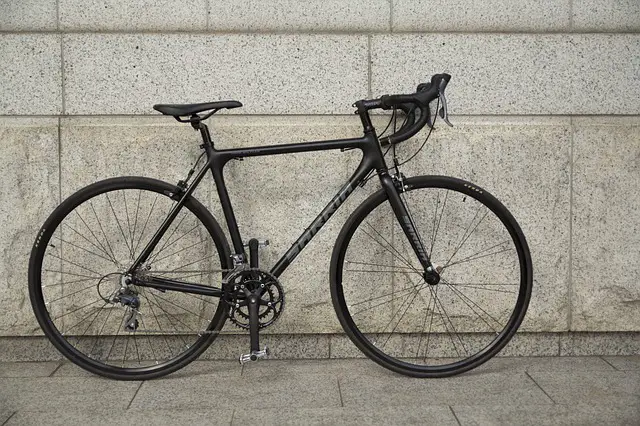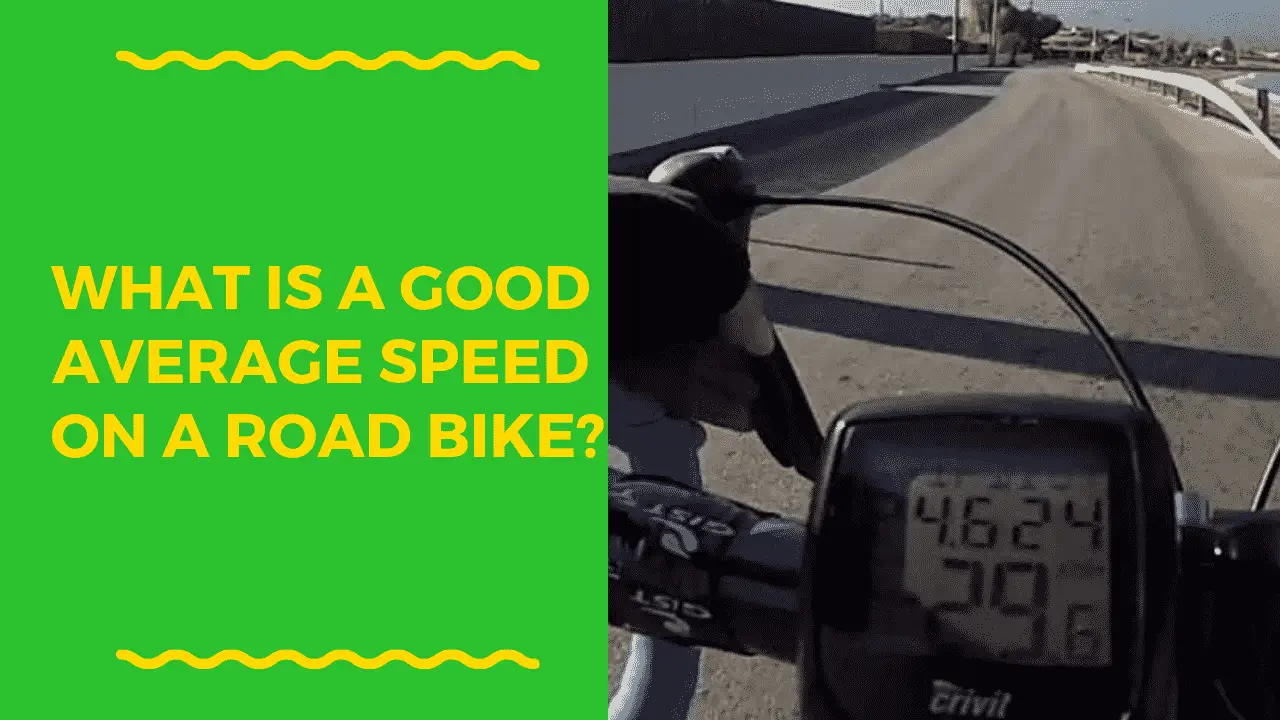While determining the average speed of a bike, many factors need to be put into consideration. The cyclists’ age, fitness level, and expertise, and other factors play a role.
On average, bike speed can range between 10 and 14 mph for beginner cyclists and increase up to 25 mph on flat terrain with moderate wind resistance for a pro cyclist on a road bike.
This article looks at different bikes and the average speed of each under the assumption that all aspects are similar. Let us look at the different types of bicycles and how their speed measures on average.
Types of Bike | Average Speed |
Road Bikes | 15 to 25mph |
Touring Bikes | 10 to 15mph |
Mountain Bikes | 17 to 30mph |
Track Bikes | 20 to 28mph |
Folding Bikes | 10mph |
Cruiser Bikes | 3 to 15mph |
Hybrid Bikes | 11 to 18mph |
Electric Bikes | 12 to 25mph |
Cyclocross Bikes | 11 to 18mph |
BMX Bikes | Up to 35mph |
Contents
Speed on different types of Bicycles
1) Road Bikes

The average speed on a road bike is between 15 mph and can increase to 25 mph with regular cycling. They have thin tires and dropped handlebars for easy cycling. The frame is light, and they are excellent for fitness, daily cycling, and speed.
For optimum speed, you can try varied positions that can help in thrusting the bile forward. A road bike moves on different terrains with little effort and is a good option if you care about speed.
2) Touring Bikes
The average speed on a touring bike is about 10-15 mph considering you will be riding long distances Touring bikes are perfect for long-distance cycling and touring.
They have a firm structure capable of carrying loads both from the front or back. They have disc brakes for expedited stopping and are made for long-distance cycling and not for speed. These bikes can handle different terrains over a long distance..
3) Mountain Bikes
The speed of a mountain bike ranges between 17 mph to 30 mph when cycling uphill and downhill. It is excellent on steep terrains and rough roads enhanced by its braking system and gears.
The tires are wide and knobby to provide grip on very uneven terrains. The handlebars are flat and make it easy for the cyclist to navigate.
4) Track Bikes
These speed machines are for professional racers and athletes. On flat terrain, the average speed is between 20 and 28 mph. With a single, fixed gear, cyclists need constant cycling for higher speeds.
5) Folding Bikes
Folding bikes are a perfect travel companion for their portability. You can carry them anywhere effortlessly and utilize them when you need them.
Their average speed is 10 mph, which is slower than most bicycles because they are made for convenience and not speed. They have distinctively small wheels allowing you to ride smoothly on potholes or bumps.
6) Cruiser Bikes
If your aim is speed, a cruiser bike will not fit the bill. Cruiser bikes are more for leisure cycling than speed cycling. However, depending on its model and your cycling skill, the speed can go from 3 mph to 15 mph.
7) Hybrid Bikes
It is an all in one bike with characteristics of a mountain, road, and touring bike. If you are only looking for a means of transport, this bicycle is an excellent choice. They offer effortless cycling with flat handlebars and stability from their wider tires. Hybrid bikes have an average speed being 11 to 18 mph, which is above most bikes.
8) Electric Bikes
Electric bikes are quickly gaining popularity among commuters for their speed and ease of cycling. The electric motor lifts some effort off pedaling and has an average speed of 12 mph and 25 mph on the high. It is a perfect choice for the everyday commuter.
9) Cyclocross Bikes
The bike borrows features from road bikes and hybrid bikes. The dropped handlebars are similar to road bikes for easy navigation, while the wheeling system is more similar to the hybrid bike. They are perfect for off-road cycling with a relatively good speed averaging at 11 and 18 mph.
10) BMX Bikes
These are sports racing and stunt performance bicycles. It is designed for sports and performance and, therefore, very sturdy. They are speed bikes, and average speed can go up to 35 mph.
What causes Slow Cycling Speed?
- Your bike’s condition - Underinflated or overinflated tires make cycling difficult besides the inability to increase speed. You will end up tiring yourself out without much success on speed. A poorly serviced bike adds resistance, slowing you down. The maintenance of your bicycle is vital to your cycling speed.
- The weight of the bike - Lighter bikes need less effort to pick up speed. Heavier bikes generally have a lower speed.
- Your Fitness level - You should be able to pedal well enough to achieve increased speed. Being even a little overweight has an impact on your cycling strength and therefore speed.
- Weather conditions - When cycling against strong winds, there will be a drop in your speed despite your bike’s condition or cycling skill and experience.
- Your cycling posture - An incorrect posture might not just be slowing you down but causing you health problems too. If you don’t feel comfortable while riding, you might consider switching your sitting position. A poor cycling technique will make you slower as it decreases your resistance to wind.
- Your cycling gear - Wearing the wrong clothes can hinder your movement, navigation, and comfort while cycling. Wind trapped under the clothes keeps you from achieving speed.
- Your route and terrain - Cycling on a busy street or a route with many stops and turns will impact your speed. Having to stop or slow down just as you are catching cycling momentum takes you back to zero. Isolated roads and flat terrains are better for speed than busy streets and hilly routes.
How to Increase Cycling Speed
1) Change your Cycling Technique
Instead of sitting upright, try lowering your body, keeping your body closer to the handlebars. Also, tuck your elbows for faster movement through the wind.
Use the wind to your advantage while planning your cycling route. Go against the wind when you are fresh and with the wind on your way back. It will help you increase speed even if your energy goes down.
2) Find Cycling Company
Even though cycling solo is excellent for your technique and peace of mind, cycling with a partner can optimize your speed.
Apart from the encouragement you get, a little competition will push you beyond your average capacity. You can increase your speed between 20-30% by just cycling in a group.
3) Keep your Bike in Good Shape
It will be futile to use a good technique on a poorly maintained bike. Properly inflated tires are especially crucial to incredible speeds. They will help you glide better and more effortlessly. Check pressure before every ride to achieve better speed.
4) Ride in Intervals
Interval cycling works very well to improve speed. By cycling with intervals of fast and slower periods, you are giving yourself recovery time and the ability to accelerate each time you need to speed up. Long rides wear you out longer, making you require longer recovery time, impacting your speed.
5) Keep off the Brakes
When you keep breaking, you keep slowing down hence the need to pedal harder to increase speed again. By braking less, you can keep an average to increased speed as you can without a rollback.
6) Stay in Shape
Apart from the impact of wind on cycling speed, the other significant hindrance to speed is your body weight. Note that up to 70% of the bike’s pull is your body. Improving your physical capability and overall health is better than the best bicycle.
Staying fit is beneficial to your cycling speed, aside from being beneficial to your overall well being.
7) Wear the Correct Outfit
Loose clothing will add to the baggage and slow you down. Tight-fitting clothes help you move swiftly through the wind and keep you dry as the fabric allows sweat to evaporate. You don’t want to be too heavy while cycling because it will tire you and slow you down.
8) Choose Your Route Properly
Your route determines how fast or how slow you move. When you don’t know which way to turn or what lies ahead, you move slower. A familiar route enables you to move faster through obstacles, only slowing or stopping when it is inevitable.
9) Be Consistent
Keeping a consistent schedule for your cycling is vital to increasing and maintaining speed. Instead of long and enduring cycling, try more practical sessions that give you enough time to recover. Having quality sessions is better than quantity that leaves you unable to keep up.
Conclusion
Having said the above, it is clear that determining the average bike speed has many factors to it. For a majority of cyclists, speed does matter as it equates to advancing in their skills. Put more focus on building your strength and resistance rather than the speed.
It is easy to find yourself comparing your average speed to another cyclist, which is fine because being competitive keeps you motivated. Remember, it is all about creating a balance between the equipment, your health, and the external conditions.
With many other factors affecting movement and speed, do not fret much about it unless you are in competitive cycling. Instead, work on finding a suitable route, cycle your best, and keep track of your progress. Finally, sometimes it is psychological; if you think you can cycle faster, you will do just that.

